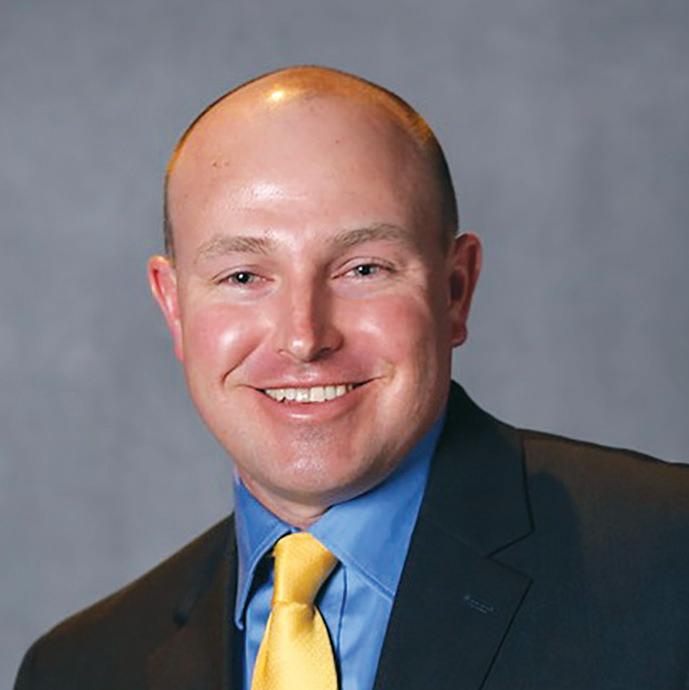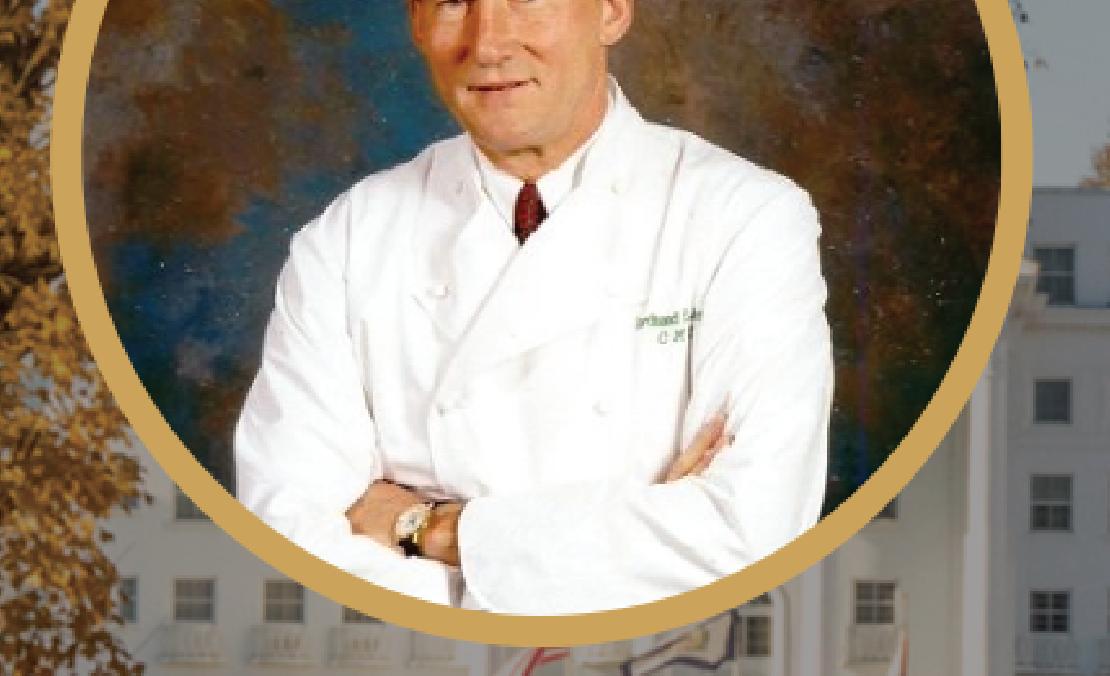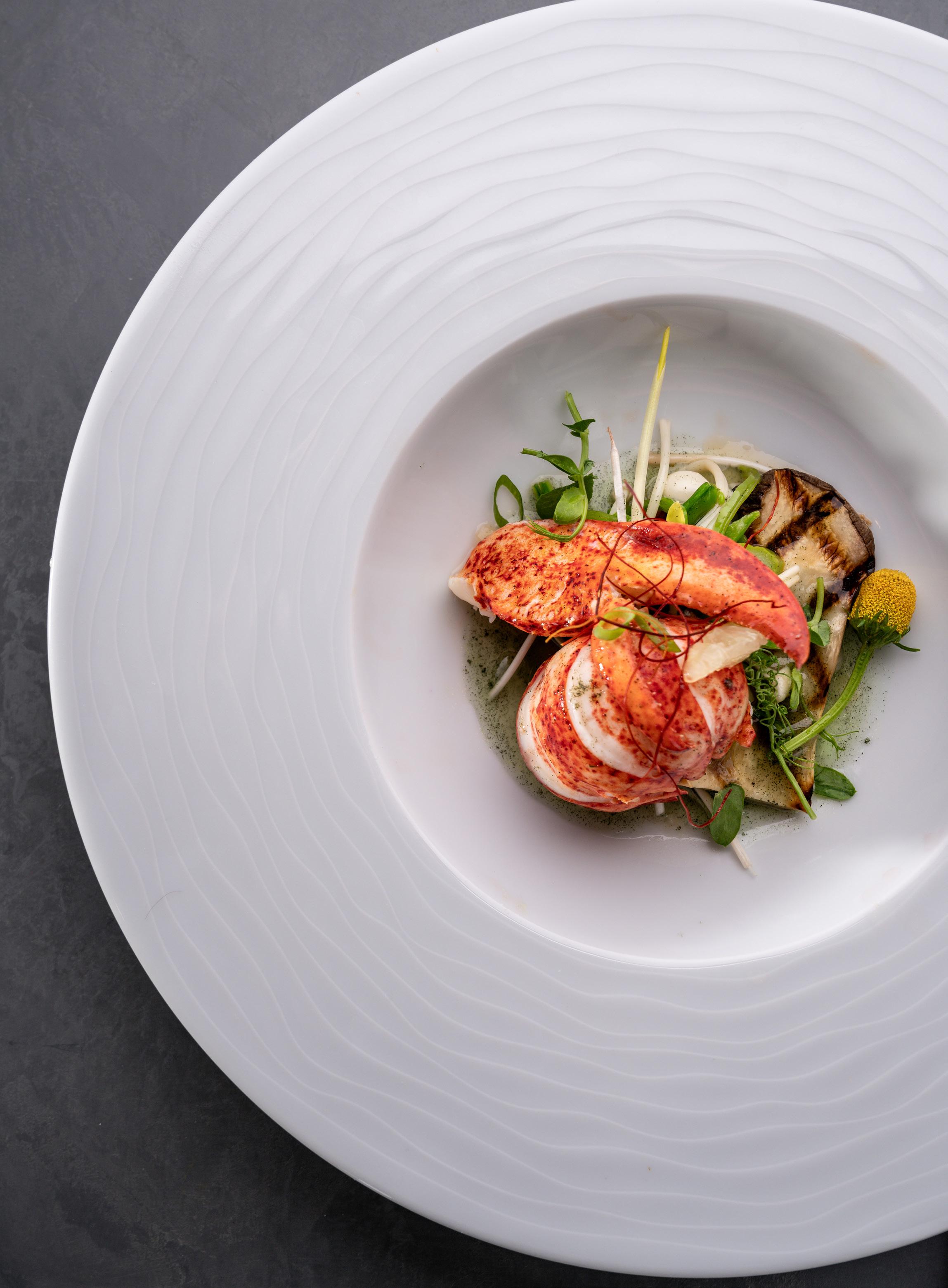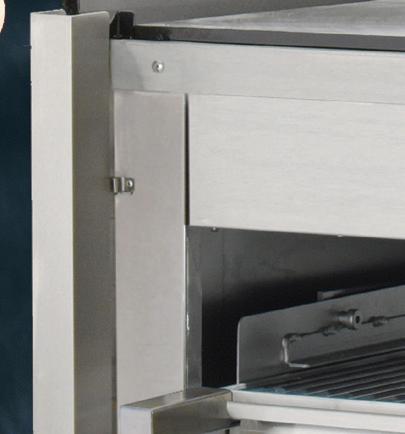




A welcoming atmosphere, digital marketing campaign, and brickand-mortar upgrades are a recipe for success at Hyperion Field Club, led by General Manager Evan Summa.






tropitone.com



Editorial Staff For Club + Resort Business
VP EDITORIAL
Greg Sanders gsanders@wtwhmedia.com 919-945-0713
EDITOR-IN-CHIEF
Rob Thomas rthomas@wtwhmedia.com 216-316-5294
SENIOR EDITOR
Phil Keren pkeren@wtwhmedia.com 216-399-9069
CONTRIBUTING EDITORS
Design + Renovation: Pamela Brill
Editorial Staff For Club + Resort Chef
EDITOR-IN-CHIEF
Joanna DeChellis jdechellis@wtwhmedia.com 412-260-9233
SENIOR EDITOR
Isabelle Gustafson igustafson@wtwhmedia.com 216-296-2041
CONTRIBUTING EDITORS
Pamela Brill
Lauren Newman Robert Mancuso, CMC, DipWSET
Production services
CUSTOMER SERVICE MANAGER
Stephanie Hulett shulett@wtwhmedia.com
CUSTOMER SERVICE REPRESENTATIVE
Jane Cooper jcooper@wtwhmedia.com
Video Services
VIDEO EDITOR
Kara Singleton ksingleton@wtwhmedia.com
VIDEO EDITOR
Cole Kistler cole@wtwhmedia.com
Leadership Team
MANAGING DIRECTOR
Scott McCafferty smccafferty@wtwhmedia.com
EVP
Marshall Matheson mmatheson@wtwhmedia.com
CFO
Ken Gradman kgradman@wtwhmedia.com
HR EXECUTIVE
Edith Tartar etartar@wtwhmedia.com
Sales Team
VP, HOSPITALITY & RETAIL
Lindsay Buck lbuck@wtwhmedia.com (774) 871-0067
NATIONAL SALES MANAGER
Amber Dobsovic adobsovic @wtwhmedia.com
BRAND LEADER Patrick McIntyre pmcintyre@wtwhmedia.com 216-372-8112
SALES DIRECTOR Tony Bolla tbolla@wtwhmedia.com 773-859-1107
KEY ACCOUNT MANAGER
John Petersen jpetersen@wtwhmedia.com 216-346-8790
REGIONAL SALES MANAGER Simran Toor stoor@wtwhmedia.com 770-317-4640
Creative Services
SENIOR ART DIRECTOR Matthew Claney mclaney@wtwhmedia.com
CREATIVE DIRECTOR Erin Canetta ecanetta@wtwhmedia.com
DIRECTOR, AUDIENCE DEVELOPMENT
Bruce Sprague bsprague@wtwhmedia.com




Events
EVENTS MANAGER Jen Osborne josborne@wtwhmedia.com
EVENTS MANAGER Brittany Belko bbelko@wtwhmedia.com
EVENT MARKETING SPECIALIST Olivia Zemanek ozemanek@wtwhmedia.com
EVENT COORDINATOR Alexis Ferenczy aferenczy@wtwhmedia.com
Digital Media/Web/Development
VP, DIGITAL MARKETING Virginia Goulding vgoulding@wtwhmedia.com
DIGITAL MARKETING MANAGER
Taylor Meade tmeade@wtwhmedia.com
DIGITAL PRODUCTION MANAGER Reggie Hall rhall@wtwhmedia.com
DIGITAL MEDIA SPECIALIST
Nicole Carnett ncarnett@wtwhmedia.com
DIGITAL PRODUCTION/ MARKETING DESIGNER Samantha Goodrich sgoodrich@wtwhmedia.com
MARKETING GRAPHIC DESIGNER Hannah Bragg hbragg@wtwhmedia.com
WEBINAR COORDINATOR Halle Kirsh hkirsh@wtwhmedia.com
WEBINAR COORDINATOR Kim Dorsey kdorsey@wtwhmedia.com
DEVELOPMENT MANAGER Dave Miyares dmiyares@wtwhmedia.com
SR. DIGITAL MEDIA MANAGER Pat Curran pcurran@wtwhmedia.com


Finance
CONTROLLER Brian Korsberg bkorsberg@wtwhmedia.com
ACCOUNTS RECEIVABLE SPECIALIST Jamila Milton jmilton@wtwhmedia.com
Branded Content Studio
DIRECTOR, BRANDED CONTENT Peggy Carouthers pcarouthers@wtwhmedia.com
ASSISTANT EDITOR Ya'el McLoud ymcloud@wtwhmedia.com
ASSISTANT EDITOR Olivia Schuster oschuster@wtwhmedia.com
Club + Resort Chef Editorial Advisory Committee
James Allen, CEC Executive Chef, Blackthorn Club at the Ridges Jonesborough, Tenn.
Lance Cook, WCMC, CEC, CCA, CFBE, FMP, CFSM Executive Chef, Hammock Dunes Club Palm Coast, Fla.
K. Scott Craig, CEC, CCA, WCMC Executive Chef, Cullasaja Club Highlands, N.C.
Laura Herman, CEPC Executive Pastry Chef, Shoreacres Lake Bluff, Ill.
Vincent Horville Executive Chef, The Metropolitan Club of the City of Washington (D.C.)
Michael Matarazzo, CEC Executive Chef, Farmington CC, Charlottesville, Va.
Robert Meitzer, CEC, CCA Executive Chef, Forest Lake Club Columbia, S.C.
Tim Recher, CEC, AAC, CWX Director of Culinary Operations, Quail West G&CC Naples, Fla.
Scott Ryan, CEC, AAC, Executive Chef, The Country Club Pepper Pike, Ohio
J. Kevin Walker, CMC, AAC
I REMEMBER IT LIKE IT WAS YESTERDAY. The fall weather had decidedly shifted toward winter and my 2023 golf season had ended. My childhood interest in tennis returned because of all the coverage we were sharing, so I decided to join a local racquet club that boasted 10 indoor tennis courts, as well as squash.
But then came the waiting game. While wait lists are a terrific sign of a club’s strength, being on the other end was brutal. I waited—patiently—and finally got in! After paying the initiation fee and several months of dues, I had only used the club three times and quit. In surfing terms, I missed my wave. I get it … I’m at fault and I often regret that snap decision. Would my family and I be using the outdoor Har-Tru clay courts or lounging by the pool this summer? We’ll never know. But one thing we do know, is that the racquets industry is still thriving … and getting ever bigger.
Because of the growing popularity of racquets, we had Jarett Chirico, Director of Racquets at Royal Oaks Country Club and the Founder/President of The Directors’ Club, on an episode of the Club + Resort Talks podcast. He and I had a wonderful conversation about everything from the importance of certifications in the racquets industry and the evolution and current state of racquet sports, to the mission and success of The Director’s Club and what the future may hold.
Jarrett has an extensive list of certifications (DCA, CRSE, PTR, PPR, PCR, PPTR, SCR, USPTA, PPTA) and explained how certification in the racquets industry has evolved. Historically, organizations like the United States Professional Tennis Association aimed to enhance the skills of teaching professionals and add value for their students, he said. Over time, as racquet sports gained prominence, the role of certification expanded.
Jarrett emphasized that while some organizations may now seem more focused on retaining members for revenue, certifications remain crucial. They provide a network, fostering connections that are vital for success. He stressed that ongoing education is essential, advocating for a continuous learning mindset over merely obtaining certifications.
One thing I really focused on in our chat was the importance of asking for help, even at the pinnacle of one’s career.
Jarrett concurred, sharing that true leadership involves vulnerability and the willingness to acknowledge one’s limitations. Effective leaders, Jarrett believes, are those who can unite a community to solve problems collectively. He underscores the value of relationships and networking, describing them as transactional in the sense of mutual benefit. He encourages celebrating others’ successes, which fosters a supportive professional environment and ensures long-term relevance and innovation.
The Directors’ Club is built upon that foundation. Jarrett describes The Directors’ Club as a unifying force in the racquets industry. He explains that traditional conferences often fall short in fostering meaningful connections, especially for those who are not wellconnected. The Directors’ Club aims to bridge this gap by bringing together leaders to share their stories and experiences in a personal, engaging manner.
The club has grown rapidly, boasting 700 members across more than 200 clubs in North America. Jarrett emphasizes the importance of genuine relationships and continuous learning in driving professional success.
The inaugural Directors’ Club retreat at Boca Woods Country Club, for example, exemplified these principles. It included high-profile speakers and ample opportunities for networking. The positive feedback from attendees underscored the retreat’s success in fostering connections and sharing valuable insights.
As for the future of racquet sports and club management, Jarrett foresees a shift toward a more integrated approach, with clubs employing Racquets Directors and Pros rather than specialists for individual sports. He believes this will enhance the overall club experience, as racquet sports touch all aspects of club life. Jarrett also anticipates a greater investment in staff, recognizing that the success of facilities ultimately depends on the quality of their leaders. He predicts a significant growth in racquet sports participation, driven by the ongoing racquets boom and increased interest in various racquet sports.
Perhaps that will, again, involve me. Returning to surf analogies … They say if you miss one wave, there’s always another one coming along.

Rob Thomas • Editor-in-Chief rthomas@wtwhmedia.com


A welcoming atmosphere, digital marketing campaign, and brickand-mortar upgrades are a recipe for success at Hyperion Field Club. (Cover and above photo courtesy of Hyperion Field Club)









● Preheats to 350° less than 10 min.
● Roast, cook, bake, air fry, rethermalize and hold with precise temperature and humidity control.
● Allows end user flexibility to increase or reduce air flow.
● In both 12KW & 8KW versions. Full & half size available!
● Non-venting; does not require a hood. (*Check your local codes)
“FAMILY FRIENDLY” HAS BECOME a buzz phrase in the country club world. I feel like I often see clubs making a concerted effort to offer a menu of programs and activities that appeal to people of all ages. It’s a trend I’ve noticed on a regular basis during my two-plus years with Club + Resort Business. So it seems appropriate that this month’s cover story spotlights how Hyperion Field Club in Johnston, Iowa, near Des Moines has transitioned from being a golf-centered club to a familycentric site.
Hyperion Field Club General Manager Evan Summa tells me that when he and other staff members give a tour of the club to young families, the message is “we’re here for everybody.”
Summa shares two examples of what the club has done to promote a welcoming environment for families. Hyperion in 2023 hosted a Relay Night for the youth swim team where team members and their families competed against each other in a wide range of races and games. This past spring, the club hosted a Divot Party where about 60 people (adults and children) spent time on a Sunday afternoon helping Summa, the golf course superintendent, and the director of golf fill divots on the golf course. I thought this was a great way for parents and children to work together on a task that involves giving back to the club. It gives members a sense of pride and ownership in the club that I think increases the likelihood that they will start using or continue using the facility at a high rate.
The headline of the story about Hyperion— “Family Spirit”— refers to both the club’s family atmosphere and to the culture that Summa is striving to create among his staff members.
“I’ve tried to create…a very caring and empathetic environment for the staff,” Summa shares. “We want them to feel valued.” He sees a connection between fostering a compassionate atmosphere for his employees and having those staffers carry that mindset with them as they interact with members and guests.
“[The staff members] are going to treat the members like family too,” Summa says.
When we grow up, we all learn some version of The Golden Rule, but sometimes that value system can get lost as we try to meet deadlines and fulfill obligations. With that in mind, it never hurts to remind people about the importance of treating others with dignity and respect. It can definitely go a long way.
Our Annual Ideas Issue typically includes excellent examples of programs and events that clubs offer that fall under the “family friendly” category. In 2023, I wrote about Detroit (Mich.) Athletic Club hosting an art exhibition for young members up to age 17, and about Champions Run in Omaha, Neb. regularly offering an assortment of games
for all ages at its pool. In 2022, I wrote about a Reindeer Run event on the golf course cart path at Salisbury Country Club in Midlothian, Va. At the time, Dan Jordan, Salisbury’s Clubhouse Operations Manager, said a large number of young families had become members in the last five years and Reindeer Run was one of many activities that catered to that demographic. I also penned a story about Farmington Country Club in Charlottesville, Va. launching an Adventure Camp to offer summer activities for 11 to 15-year-olds, a group that is sometimes overlooked.
I’m interested in hearing from other clubs that have followed in the footsteps of Hyperion Field Club and consciously shifted toward a more family friendly atmosphere. Why did you decide to do it? How has it been received by the membership? Did you attract more members by making that change? On the flip side, did you lose any long-time members who weren’t supportive of the new approach?
You can keep the conversation buzzing by e-mailing your thoughts to pkeren@ wtwhmedia.com.

Phil Keren • Senior Editor pkeren@wtwhmedia.com


By Michelle Polak • CMP Bookkeeper/Membership Director • Yellowstone Country Club
AT THE YELLOWSTONE COUNTRY CLUB, a private, member-owned club established in 1949, we pride ourselves on offering a superior club experience every day. With more than 700 members, including 500 full golfing memberships, our mission is to create an environment where both members and guests feel uniquely valued and connected.
When I assumed my position in 2017, the onboarding process was straightforward, yet lacked a personal touch. Members would fill out an application, await board approval, and become a part of our community. Initially, we provided membership baskets that the new member had to personally come pick up, but as these began to pile up in our office, unclaimed, we realized the need for a change. This led to the discontinuation of the baskets, a decision that surprisingly didn’t draw much attention. However, with the reorganization of duties in early 2023, I saw an opportunity to revitalize and personalize our approach to welcoming new members. This endeavor began modestly with a gift of a postcard set featuring the original architectural drawings of our renowned golf course and their By-Law/Rule book.
Our new member welcome boxes have since evolved into a more robust and thoughtful offering. Each box, adorned with lively images of our club, contains a carefully selected array of items:
• A travel bag to enjoy the extras that are needed for the pool
• Specially branded golf towel for only the new members (this lets me see how many members are using their goodies!)
• Two pairs of stylish sunglasses
• YCC-branded lanyards and keychains, adding a touch of exclusivity
• A four-postcard set showcasing the original designs by Robert Trent Jones, Sr.
• A Rule & By-law and membership directory book, pens, notepads, and stickers (I like to make sure there are two stickers for every kiddo!)
• A unique USB flash drive loaded with essential membership documents and a warm “Welcome to the Club!” message
These items are meticulously hand-tied with a branded ribbon, topped off with a beautifully handcrafted bow. This personal touch, I believe, sets our welcome boxes apart.
The response to the new boxes has been overwhelmingly positive. New members appreciate the immediate access to crucial membership information, and existing members have expressed a desire for such a thoughtful welcome. Interestingly, our older members often call to inquire about the ‘doohickey,’ referring to the USB flash drive! In their defense, if you didn’t know technology well, you wouldn’t know it was a flash drive!
Looking ahead, our goal is to tailor these boxes more specifically to each new member’s type of membership. For example, resident members might receive golf balls, while court sports and pool members could find goggles and tennis/pickleball balls in their welcome kits.
This project holds a special place in my heart. I adore my job and our clubhouse, and through these welcome boxes, I get to share a piece of this love and pride with every new member. It’s not just about handing out gifts; it’s about crafting an onboarding experience that resonates with our members’ passions and interests, fostering a deeper connection with our club from day one.
As we continue to innovate and adapt, our focus remains on enhancing the member experience, ensuring each individual feels a part of our cherished YCC family. Stay tuned for more updates as we embark on this exciting journey of creating memorable, personalized welcomes for every new member who joins our esteemed community.

A welcoming atmosphere, digital marketing campaign, and brick-and-mortar upgrades are a recipe for success at Hyperion Field Club.
By Phil Keren, Senior Editor
SERVING AS THE LEADER of Hyperion Field Club in Johnston, Iowa is a homecoming for Evan Summa.
“Hyperion’s truly a special place for me,” says Summa, who has worked at the club for 12 total years and served as its General Manager for the past year.
“My folks joined [the club] in 1993. I learned how to play golf here. I learned how to swim, I learned how to play tennis, [I] learned how to act when you go up to a country club.”
In addition to growing up at the club, Summa’s first job was as a bag boy in Hyperion’s golf shop while he was in high school. After earning a bachelor’s degree in hospitality management from Iowa State University, Summa secured an internship that eventually became a full-time job at Interlachen Country Club in Edina, Minn.
“I was kind of unsure about living in the cities,” Summa recalls. “A great place to live during the summer, [but] the winter gets a little cold.”
So when an entry-level position became available at Hyperion in 2012, Summa notes “it just felt right” to return to the place where he learned to swing a golf club and do the Australian crawl.

“I’ve been very fortunate to work my way up the ladder here to GM,” Summa says. “[It’s] definitely a special place for me. A lot of memories here.”
Considering this history, it’s not surprising that Summa and his staff have worked to transform the club from a “golf-centric” facility to one that is familycentered. Summa believes this approach succeeded in the summer of 2023 and hopes the progress continues this year.
As it’s evolved to become a club for all age groups, Hyperion recently invested in a digital marketing effort, sold 30 acres of land that will be converted into a members-only, residential golfing community that will consist of 27 luxury homes, and completed a clubhouse and kitchen renovation.
Located about 10 miles from Des Moines, Hyperion Field Club has approximately 550 members and offers an 18-hole championship golf course, a driving range, tennis facility, swimming pool, banquet facility, poolside grill, full-service kitchen, fitness center, group fitness center and two dining rooms. Summa notes the myriad changes at the club all contribute to creating “The Hyperion Experience.”


Developing a family-friendly atmosphere at Hyperion starts with the employees.
“I’ve tried to create…a very caring and empathetic environment for the staff,” Summa says. “We want them to feel valued, we want them to… be excited when they come to work, excited when they work, and then…feel good when they go home.”
The key is to cultivate a strong connection among employees, as well as between the staff and club members.
“If you care about people, they’re going to care about you, and they’re going to care about their job, and they’re going to take pride in it,” Summa notes.
Fostering a caring and connected atmosphere carries over to employees’ interactions with members and guests. When club employees give a tour to young families, the message is “we’re here for everybody,” Summa shares.
This past spring, the club hosted a Divot Party where about 60 people (adults and children) spent time on a Sunday afternoon helping Summa, the golf course superintendent and the director of golf fill divots on the golf course. Afterward, the 15 families enjoyed pizza and pop as a thank you for their hard work.
“You just take a sense of pride with that,” Summa says. “I’m driving one of the carts that’s got all the seed and soil, and you got these kids coming up there wanting to get dirty. That’s awesome and they take pride in their golf course and their club.”
Last year, the club hosted a Relay Night for the youth swim team where team members and their families competed against each other in a wide range of races and games.
Thanks to the rise in the number of members and the increase in dues revenue, Summa says the club now offers nearly all of its family events to members free of charge.
“I know the membership appreciates it and it drives them out to the club,” Summa says. “If an event’s free, they’re probably going to go to the restaurant and have dinner afterwards.”
An emphasis is being placed this year on enhancing the “Hyperion Experience,” with Summa encouraging his employees to figure out how to build on the successes of last year. At the same time, he wants his staff to assess events that came up short and examine what improvements they can make.
All of these family-friendly events are being publicized and promoted through multiple digital marketing efforts. Summa kept a close eye on the digital marketing tactics of Ben Lorenzen and his marketing team at Champions Run in Omaha, Neb., and became interested in employing some of these approaches. A former club employee later started a company called TH Media, which Summa says has “totally rebranded” the club’s social media, marketing and e-mail communications with the “Hyperion Experience” label.
TH Media puts videos of club events on Facebook that are targeted toward specific people in the community. The club will encourage members to like or share a social media post and by doing so, they will have a chance to win prizes such as a reserved parking spot at the club. Seeing a video of an event such as a
wine dinner may help encourage a member to attend a similar program. Podcasts are created and posted on a regular basis, too.
“Our presence on social media, the Facebook [posts], the Instagram [posts], the TikToks…got our message out to the Des Moines area and resulted in a full membership with a wait list,” Summa says. “...TH Media has done a fantastic job for us.”
Megan Martens, the club’s Assistant General Manager/Membership Director, says the digital marketing campaigns have helped bring in more than 200 new members.
“Our digital marketing strategy includes a combination of video production, social media marketing, communications and membership integration highlighting the unique value and benefits of being a part of the Hyperion family,” Martens says.
Jim Sedrel, the club’s Golf Course Superintendent, agrees that the digital marketing strategy has helped the club grow in a significant way.
“I can’t tell you how many of my friends our social media has reached,” Sedrel says. “They’re like, ‘I want to join, it looks like so much fun is being had at Hyperion!’”
Summa adds the club continues to pursue creative approaches to its social media campaigns.
“This will be year five with [the digital marketing efforts],” Summa says. “It’s some of the best money we could spend.”
Megan Martens, Assistant GM/Membership Director at Hyperion Field Club, says digital marketing efforts have helped bring in more than 200 new members.

LUXURY HOME PROJECT IS ‘A GAME CHANGER’
Major changes are also happening in Hyperion’s brick-andmortar world.
In 1991, the club purchased about 55 acres of land and built a driving range on approximately 25 of the acres. Since then, Summa says, the club has been looking for a way to use the remaining 30 acres. A solution materialized when Scott and Stephanie Denton from Denton Homes approached Hyperion leaders with a plan to purchase the land to build a members-only, high-end golf community called Carmel Hyperion that will have 27 luxury homes.





Hyperion Field Club Golf Course Superintendent Jim Sedrel (right), says the enhancements being made to the course’s short game area “will be a big improvement to our offering.” Director of Golf Adam Pritchard (left) adds that members will be able to sharpen their 50-yard pitch shots.
Denton Homes bought the land in summer 2023, the groundbreaking happened last fall, and site work on the wooded lots continued throughout most of the winter.
“We couldn’t be more excited to partner with Denton Homes,” Summa says. [This is] really a game changer for the club.”
Summa says they hope to close on the lots in early July and begin digging foundations later in the summer. The developer will soon finish installing roads and utilities on the site, and the city is expected to approve the plat for the project shortly thereafter. The goal is to sell all 27 lots in the next five years.
“Homeowners will be required to be members of the club,” Summa says. “When a lot is sold, the initiation fee is paid to the club, and then they become members right away. Then they begin building their home.”
Homeowners will be allowed to have a golf cart at their home that they can drive to and from the club.
As plans for the Carmel Hyperion development continue, new target greens, a turf hitting mat and a putting green were added to the driving range.
Adam Pritchard, the club’s Director of Golf, says the target greens were expanded and centered up on the range.
“This greatly matches what our members experience on the course instead of the smaller target greens that we offered before,” Pritchard says.
Pitching greens have also been added to the area so golfers can practice short- or medium-range shots.
“Each side of our range features a green about 50 yards off the tee box to help with short game improvement,” Pritchard says.
Hyperion has partnered with Minneapolis-based architect Paul Miller to install a short game area, with the work expected to begin in July.
The previous short game area, according to Pritchard, had a chipping green with a severe break to a player’s right. He says the new area will be “much more dynamic.”
“The plan will be to have a 6,000-sq.-ft. green surrounded by bent grass and uneven lies with two bunkers to address all short game problems,” Pritchard says. “This will be a destination area for our members to try and fix their short game problems.”
The driving range has gone through various iterations, but Sedrel notes the new version “will usher in enhanced short-game areas which will be a big improvement to our offering.”
The sale of the land included a component that is pivotal to the upgrade of the practice area.
“Part of the purchase agreement with the sale of the land requires the developer to do all the grading of the new practice area,” Summa adds.
The club conducted a survey of its members in fall 2022. The top two requests? Members wanted to see the clubhouse refreshed and the addition of an adults-only restaurant. Both requests have been fulfilled during the last couple of years as the club used proceeds from the sale of land to Denton Homes to pay for these projects and to purchase equipment for the golf course.
Hyperion recently finished the second phase of its clubhouse master plan. The interior of the building was completely refreshed—including the kitchen, hallways, front entry, lobby, and banquet space. New furniture, carpet and light fixtures were installed in the banquet area and the walls got a fresh coat of paint.
“It really brightens the place up,” Summa says.
The upgrade, according to Summa, makes the banquet space “more marketable for members to host their events here, which we’ve seen an uptick in.”
Martens adds: “The clubhouse refresh is a significant milestone in enhancing the ‘Hyperion Experience.’”
Meanwhile, an existing banquet room space was converted into an adults-only dining area. The restaurant, which is called The Greens, opened for business in the middle of spring. This new project illustrated another way in which Hyperion is trying to meet the needs of all of its members.
“We had one restaurant and it was for everybody,” Summa explains. “We’re a family club…but there’s also a portion of the membership…that want a space that they can go [to], have dinner and it’s just adults. That’s what we’ve delivered on.”
The Greens has 40 seats in the dining room, about 10-11 seats around the bar, and uses a reservation system.
“People are excited to come up here [to The Greens],” Summa says. “Maybe they put on a sport coat and dress up a little bit…[It’s] a little more entree focused…It’s still a casual restaurant, but it definitely has that upscale feel.”
This fall, the club’s front entrance will be reconstructed and

Hyperion Field Club recently upgraded its event space. New carpet, lighting and a fireplace were installed in this area. The space also got a fresh coat of paint.
He is quick to credit the membership for backing all of the improvements happening at the club where he grew up.
“A lot of these projects were kind of wants way back when and now we’re making them a reality and couldn’t do it without a full membership and their support of the club,” he says.



Newly designed spaces invite kids of all ages to stay and play.
By Pamela Brill, Contributing Editor

NO BABYSITTER? NO problem. When parents bring their kids to the club, they can be assured that every member of the family will enjoy their visit, even if they aren’t together the entire time. With the number of family memberships growing by leaps and bounds, more facilities are investing in play spaces that let parents drop off their kids while they take advantage of other amenities. Here are three properties that kicked off the summer season with newly designed kids’ clubs for their youngest members.
When kids don’t want to leave the club because they are having such a good time, it’s a surefire sign that Parkland (Fla.) Golf & Country Club is the place to be. The recent opening of the Kids Cove has upped the family fun factor by designating a place to play when on the premises.
“We recognized the importance of providing a dedicated space for children, so we aimed to create
a welcoming and engaging area where kids can enjoy themselves while their parents take advantage of other club amenities,” says Director of Sports, Fitness & Wellness Shane Labuschagne.
The Kids Cove is primarily used as a drop-off playroom for ages 3-12. Labuschagne describes the atmosphere as “vibrant and cheerful,” welcoming kids with colorful accent walls in pops of blue, red and yellow and a spacious setting with a variety of activity zones. The flexible layout allows kids to easily move between activities, be it board games at child-sized tables or playing video games in comfy chairs. “With a maximum capacity of 20 kids, we strive to maintain a balance offering personalized attention and fostering a social atmosphere where children can interact and have fun,” he notes.
In addition to free play, the Kids Cove hosts weekly events for young members, so that furnishings can be reconfigured as needed. The club can cater to different interests and age groups with movie nights and Fun Fri-

Parkland, Fla.
“We recognized the importance of providing a dedicated space for children, so we aimed to create a welcoming and engaging area where kids can enjoy themselves while their parents take advantage of other club amenities.”
- Shane Labuschagne, Director of Sports, Fitness & Wellness
days, among other activities. Beginning next month, the Kids Cove will reserve Tuesday and Thursday mornings to host playtime for toddlers and their parents.
Since the opening, the club has received extremely positive feedback—and not just from parents.
“What’s particularly heartening is that the children themselves have expressed a strong desire to stay longer once they’re here,” says Labuschagne. “Their enthusiasm is truly the best endorsement we could hope for.”
The continued growth of family memberships at The Standard Club of Johns Creek, Ga., has spawned a kids’ club that opened its doors last month. With parents in search of activities that could occupy their children
while on the premises, management heeded the call for expanded family-oriented offerings.
“Feedback from our members emphasized the demand for a fun, engaging and safe environment for children, while parents utilize other club facilities,” explains Director of Membership & Marketing Emory Patton.
The 800-sq.-ft. kids’ club, conveniently connected to the clubhouse and next to the restroom area, serves as both a free play area and childcare facility for ages 4 and up. Cushioned, soft gray carpeting ensures both safety and comfort, while furnishings in a rainbow of blues, green, yellow and orange add a playful vibe. Tying into this color palette is a custom-made mural, created by a club member whose two daughters take part in junior activities.


Johns Creek, Ga.
“Feedback from our members emphasized the demand for a fun, engaging and safe environment for children, while parents utilize other club facilities.”
- Emory Patton, Director of Membership & Marketing
With room for up to 20 kids at a time, kids can partake of any number of activities, stationed in their own respective areas. Standout attractions include a car track, reading nook, arts and crafts area and building blocks corner. Soft modular couches, along with childsized tables and chairs, provide ample accommodations for groups of visitors.
In its first two months alone, the kids’ club has proved its usefulness as a play center and reliable pickup/drop-off point for young members. In the future, the club plans to offer childcare during adult events like music bingo and couples’ nine and dine.

“This setup encourages camaraderie among juniors and allows parents to connect with friends in a relaxed atmosphere,” says Patton.
And with so many families already singing the praises of the Standard Club’s newest entity, she expects the kids’ club to thrive in the months ahead. “Parents have expressed their enthusiasm for having a dedicated space where their children can play, learn and socialize safely,” adds Patton. “Many have shared that this new amenity enhances the overall appeal of our club, making it a more inclusive and enjoyable place for their entire family.”
Canyon Creek Country Club in Richardson, Texas, is taking youth programming to a whole new level. Earlier this summer, the facility unveiled the Treehouse, a play space with a flexible layout to accommodate camps, structured activities and special events. The greatly anticipated opening coincided with Canyon Creek’s new dining facility, further elevating the club’s profile as a family destination.

With room for up to 20 kids at a time, kids at The Standard Club can partake of any number of activities, stationed in their own respective areas.
Richardson, Texas
“This dedicated space allows us to cater to the needs of all family members, while fostering creativity, socialization and learning through various age-appropriate activities and programs.”
- Whitney Jackson, Director of Member Experience

The construction of the Treehouse was in response to the growing demand for family-friendly amenities.
“Many of our members expressed a desire for a safe and engaging space for their children to play, while parents enjoy some relaxation or participate in their own activities at the club,” says Director of Member Experience Whitney Jackson. “This dedicated space allows us to cater to the needs of all family members, while fostering creativity, socialization and learning through various age-appropriate activities and programs.”
Located by the concierge desk, the Treehouse beckons young children and their parents with convenient drop off immediately upon entering the club. A kids’ club attendant is on hand to supervise free play for those potty trained and older (up to age 11), with a maximum occupancy of 10 kids to ensure a safe experience. Designated zones feature a variety of activities, including arts and crafts, reading and imaginative play. These areas are stocked with age-appropriate toys and special features, such as a chalkboard and treehouse-themed bookshelf.
A cool palette of blues and greens welcomes kids to the room. Soft flooring was chosen for its ability to withstand crawling and active play, while adjustable lighting works just as well for quiet time as it does for active kids.

The immediate use of this space will be focused on open play, but Jackson notes how the customizable design can lend itself to camps and kid-themed events like crafting workshops or movie nights.
“We can plan summer camps with smaller group sizes and utilize the space for rotating activities,” she explains. “For example, one group might participate in arts and crafts, while another group enjoys outdoor play and then they switch.”
Speaking of crafts, member kids were given an opportunity to paint and decorate birdhouses that tie into the Treehouse theme. Each creation will be suspended from the ceiling and become part of the permanent décor—and a reminder of happy times spent at Canyon Creek. C+RB
> Clubs are responding to members’ desire for amenities reserved exclusively for their children, while they enjoy other facilities on their own.
> Flexible kids’ club layouts allow them to be changed up as schedules dictate, from open play to special events.
> The design approach for kid-centric spaces calls for vibrant colors and comfortable, yet functional furnishings.









Following a $42 million renovation and key leadership changes, Executive Chef John Muriel and the team at Broken Sound Club hit all the right notes, balancing member expectations with exceptional service and strong leadership.

SHORTLY AFTER OUR LAST ISSUE, we released “All Ships Rise: A Documentary by Club + Resort Chef.” This film delves into the professional journey and impact of Scott Craig, CEC, CCA, WCMC, Executive Chef of Cullasaja Club and Contributor to Club + Resort Chef, the Chef to Chef Conference, and PlateCraft.
In the film (and in real life), Chef Craig speaks about building a family, learning from mentors, and refining the craft for future generations. He believes the culinary profession is about more than creating good food—it’s about fostering a supportive and innovative community. Chef Craig has a unique ability to see potential in others and bring out the best in them, creating an environment where everyone feels valued and motivated.
Making this film allowed us to paint a picture of what I believe it means to be a club chef. It goes beyond the kitchen; it’s about leadership, community, and relentless evolution. A club chef wears many hats, from innovator to mentor, and their influence extends far beyond the plate.
“All Ships Rise” captures the heart and sou of club culinary, highlighting the intricate balance between innovation and tradition, individual talent and teamwork.
I didn’t realize until after the fact, but collaborating with Kara Singleton, Director and Cinematographer, and Isabelle Gustafson, Senior Editor, to bring this documentary to life shares many of the same principles. Just as club chefs nurture their teams and foster creativity, we uplifted each other, creating an environment where our collective talents could shine.

This project was challenging at times—especially for Singleton who did the lion’s share of work in composition and editing—but our belief in the importance of the story and our mutual support carried us through.
Singleton brilliantly titled the film “All Ships Rise” because it embodies Craig’s belief that when one person excels, everyone around them benefits.
This film not only celebrates a culinary giant but also serves as a broader commentary on the industry. Other club chefs embody the same dedication, creativity, and passion that Scott Craig does, and their stories deserve to be told. By sharing these narratives, we hope to inspire others in the industry to recognize the incredible impact they can have on their communities. “All Ships Rise” is just the beginning, and we’re committed to keeping the tide high, telling important stories, and showcasing the remarkable individuals who define what it means to be a club chef.
EDITOR-IN-CHIEF


Joanna DeChellis jdechellis@wtwhmedia.com 412-260-9233

26 Achieving Harmony: Inside Broken Sound Club’s Culinary Evolution
Following a $42 million renovation and key leadership changes, Executive Chef John Muriel and team hit all the right notes, balancing member expectations with exceptional service and strong leadership.
30 Insights From the 2024 Kitchen Renovation Survey
The recent survey highlights key challenges and priorities of club kitchens, emphasizing proactive planning and the pivotal role of culinary leaders in renovation efforts.
36 Charting a New Course: From Ocean to Dry-Ager to Plate Farmington Country Club’s Executive Chef, Michael Matarazzo, CEC, is enhancing menus with dry-aged fish.
38 Clubs Raise the Bar for Family-Friendly Functions
With thoughtful planning and a strategic execution, orchestrating events for any age level can be child’s play.
40 Behind the Burners: On Cooking, Challenges, and Capes
Chefs Daniel Montano and Shawn Olah explore their culinary journeys, discussing leadership challenges, personal influences, and their unique takes on a hypothetical superhero identity.
Following a $42 million renovation and key leadership changes, Executive Chef John Muriel and the team at Broken Sound Club hit all the right notes, balancing member expectations with exceptional service and strong leadership.
By Isabelle Gustafson, Senior Editor

in Boca Raton, Fla., reopened after a three-year, $42 million renovation with two new restaurants: Zest, featuring small plates and sushi, and Cirq Grille and Bar, offering elevated classics. Since then, Michelin-starred Chef Bogdan Danila departed as Culinary Director, marking the start of a series of significant leadership changes.
“It’s been transition after transition,” says Executive Chef John Muriel, who oversees Cirq and a robust banquet operation, alongside Michael Bass, Executive Chef of Banquets. “But plans never go accordingly, especially in this type of business. The challenges we face make us better.”
Today, with additional renovations and plans in the works, Muriel, Bass, and a talented team of front- and back-of-house staff work together to meet and exceed the expectations of more than 3,000 members.
“About 75% of the work is building relationships,” Muriel says. It’s a skill that comes naturally to him, honed at Manhattan hotels but perfectly suited to a Boca club.
Muriel grew up in Queens and was the first in his family to pursue higher education. He graduated with a degree in hospitality management from the New York City College of Technology.
“I ended up really enjoying the kitchen—the atmosphere, everything about it,” he says.
One of Muriel’s first jobs was with the InterContinental New York Barclay, followed by the Millennium Hilton.
“There, I picked up quite a bit of passion and momentum in my career,” he
notes. “I was promoted to sous chef. After seven years, I left to be a sous chef at Crowne Plaza in Times Square. That property was a beast—800 rooms right in the middle of Times Square. That was one of my most challenging jobs. But it was also the most rewarding because I learned the most.”
In 2013, Muriel joined The RitzCarlton New York as a sous chef, then executive sous. A few years years later, Greg Devino, who Muriel had worked with at The Ritz, connected him with John Crean, CCM, CCE, then-GM and CEO of Broken Sound, who was looking to hire an exec sous. After some consideration, Muriel made the move South.
“I met my wife at The Ritz-Carlton; she oversaw one of the lounges,” Muriel explains. “She grew up in Boca, and it was always her idea to come back.”
Muriel admits that the transition from New York City to Florida—and from hotels to clubs—was jarring at first.
“It was tough,” he says. “Coming from New York, with its food scene—I missed it. And the job was completely different from what I was used to. But I can honestly say I love it now. I couldn’t see myself anywhere else.”
After four years as executive sous chef, Muriel left Broken Sound for an executive chef position at Delaire Country Club in Delray Beach, Fla. But he kept in contact with his former colleagues. A year later, he was back.
“Because [Broken Sound] was going through a renovation, they asked me to oversee the new restaurant and the opening procedures,” Muriel says. “The people who work here are tremendous, and the opportunity to put my insight

John Muriel, Executive Chef of Broken Sound Club’s Cirq Grille and Bar, is a talented culinarian and a dedicated leader, committed to fostering a positive environment and empowering staff to provide exceptional service to members.
and my imagination into this restaurant enticed me. It felt like a good time.”
After Muriel rejoined the team in mid-2021, there were quite a few major management changes. In 2022, Crean retired after nearly 20 years as GM. He was succeeded by Ritz-Carlton alum Devino. In mid-2023, Devino left, and at the start of 2024, Broken Sound hired Ken Kosak as GM and COO. The club had also hired Danila, a Michelinstarred restaurant chef, in 2022 as Culinary Director. When he departed in July 2023, the club did not replace him.
“[Muriel] was put in the position to make changes and decisions on the fly,” says Junior Sous Chef Margarita Rodriguez. “We all rallied behind him. There’s a lot of respect—mutual respect—that made it happen.”
Muriel cites his management style and the relationships he’s built as his proudest accomplishment as a chef.
“In some of the jobs I had when I was young, I would see how management treated us—lack of respect, treating you like you were just a number,” Muriel says. “I knew I was going to be a chef some-



day; I always told myself that this wasn’t the manager I wanted to be.”
Respect, Muriel says, is not guaranteed as a leader; it’s earned.
“Just because I have a title doesn’t mean I know more than a cook who’s been in the kitchen for 40 years,” he says. “There’s a lot that person could teach me. The way I look at it, I just chose a different responsibility and a different way to go about the kitchen.”
At Broken Sound, Muriel greets each team member every morning, and he makes the rounds again before he leaves. He views leadership holistically. Staff are people first and foremost.
“[Chefs] tend to lose track of that,” he says. “We’re very task-driven, and we’ve got to get things done, but we forget the human part of it all.”
“He is very concerned about not only what’s going on work-wise, but he also asks us how we’re doing, how our family is,” says Rodriguez. “And he stresses balance; it’s not all about work.”
Muriel is adept at delegating, Rodriguez adds, and he empowers staff to make decisions and go above and beyond for members.
“Our job is in the details,” Rodriguez says. “There’s a member who brings in a special cheese she can only get in her hometown. A lot of places [frown upon] requests like that; they don’t realize that’s part of our job. It’s not just cooking—it’s hospitality. Something might take longer if it’s a very specific request, but we don’t say no. [Muriel’s] big on that.”
Since Cirq opened, menus have evolved significantly. When members voiced an interest in more variety, the team took the note and ran with it.
While the lunch buffet is steady—salad bar, whole roasted salmon, burgers, vegetables, a carving station, an omelet station—dinner menus change nearly every day.
“It’s never the same,” says Muriel. “On Mondays, we do ‘burgers and brews,’ which is our most popular night. We have about seven different burgers we create, along with sandwiches, salads, small plates. On Tuesdays, we do a prefix for $45. Wednesdays, we do a Tuscan buffet, which we change every three to four weeks. We have a standing menu on Thursdays and Fridays. Then it’s a la carte with specials. Saturday night, we’re doing a steak night, and Sunday night, a themed buffet.”
It’s an ambitious schedule, with many moving parts. But Muriel describes his own culinary style as simple, with a focus on fresh, local ingredients.
“I know some chefs like to reinvent the wheel,” he says. “I prefer to keep dishes simple, elegant, tasting good and plated nicely. Keeping true to traditions is important to me.”
Rodriguez cites seafood as among Muriel’s strongest culinary skills, particularly his fish preparations.
“He has good synergy between classic techniques, but with local food,” she says. “His cooking is light, clean. It’s
Broken Sound Club’s Cirq Grille and Bar features elevated classics with a nod to tradition and a focus on fresh, local foods. Executive Chef John Muriel is known for his seafood, with preparations that let ingredients shine.
zesty and fresh. Everything’s vibrant.”
Bass, who works closely with Muriel, notes that 60% of Broken Sound’s roughly $9M in annual food-and-beverage revenue is driven by its a la carte dining outlets, and 40% comes from banquets.
“We did 22 weddings and about 14 bar mitzvahs last season,” Bass says, “plus golf mixers, tennis mixers, opening events, closing events. Our season closing was a white party celebration on the pool deck. We did a lot of stations and entertainment. It was a memorable event. The team worked together to pull it off.”
Broken Sound is now renovating The Old Course clubhouse, including its traditional a la carte venue, with plans to reopen in October under a new name. The club is also installing more pickleball courts, which Bass expects will lead to additional events.
After a successful kids’ sushi-making class, further programming is in the works, as well as workshops to refresh staff skills. Muriel aims to restart chef’s tables, and Rodriguez is spearheading a culinary garden.
“In the fall, when the weather cooperates, we’ll plant things that we’ll incorporate into our specials,” she says.
In the meantime, Muriel notes, summer in Boca is a time to regroup.
“It was tough, all the changes, everything we went through trying to get [the restaurants] open,” he reflects. “Right now, we’re starting the season fresh.”
Come fall, the overarching goal will be meeting and exceeding lofty, postrenovation expectations at every turn.
“From the start of the season until the close, we need to be all gears running at every meal, making sure the members are happy,” Muriel says. “That’s why we’re here.” C+RC
The recent survey highlights key challenges and priorities of club kitchens, emphasizing proactive planning and the pivotal role of culinary leaders in renovation efforts.
A Club + Resort Chef Report

THE DATA FROM THE 2024 Club + Resort Chef Kitchen Renovation Survey offers a comprehensive look into the current state and future needs of club kitchens. This data, gathered from a diverse range of club chefs, general managers and culinary directors, sheds light on the challenges and priorities faced by these professionals as they navigate the complexities of kitchen renovations.
The survey reveals that the majority of respondents hold the title of Executive Chef (66%), followed by General Manager (15%), Director of Culinary Operations (5%), and Director of Food & Beverage (5%). This distribution underscores the pivotal role of culinary leaders in shaping and executing kitchen renovation strategies. It affirms that executive club chefs and club culinary directors are key decision-makers in long-term capital planning. It also suggests that collaboration with General Managers is crucial to align culinary and operational goals, ensuring successful and cohesive renovation projects.
Club sizes vary widely among respondents, with membership numbers ranging from under 500 to over 5,000. This variation in membership size indicates that renovation needs are highly individualized. Larger clubs likely face greater complexity in kitchen operations, requiring more extensive and frequent upgrades to maintain service standards. Smaller clubs, while potentially less complex, still face challenges in optimizing their spaces to ensure efficiency and member satisfaction.
Regarding annual capital budgets for culinary programs, the majority of respondents (47%) have budgets under $50,000, indicating that many clubs may need to focus on smaller, incremental upgrades rather than large-scale overhauls. Meanwhile, 20% of respondents have budgets between $50,000 and $100,000, and 17% have between $100,000 and $250,000. Only 7% have budgets exceeding $250,000. This variance in budget sizes highlights differing
prioritization across clubs and underscores the importance of strategic planning and efficient use of resources to achieve renovation goals within financial constraints.
When it comes to equipment replacement, small appliances (69%) and refrigerators (65%) are the most commonly mentioned items, indicating that these appliances likely experience the most wear and tear. Additionally, ovens (40%) are also frequently highlighted for replacement, emphasizing the need for reliable and efficient cleaning and cooking solutions. Other frequently replaced items include grills (27%), fryers (27%), and freezers (23%). Less commonly mentioned but still significant are stoves (18%), dishwashers (15%), combi ovens (13%), and tilt skillets (10%). This data highlights the importance of maintaining a range of essential kitchen equipment to ensure smooth and efficient operations.

According to the survey, 36% of respondents said renovations occur as needed, while 35% reported that renovations happen only once every 10 years or more. This infrequency suggests that many clubs may be adopting a reactive rather than proactive maintenance strategy. This approach can lead to more significant disruptions and higher costs over time, as delaying necessary updates often results in more extensive and expensive repairs down the line. Proactive planning and regular updates could mitigate these issues, ensuring smoother operations and better cost management. The survey reveals that the primary triggers for kitchen renovations include expansion (53%) and equipment obsolescence (40%), indicating that clubs are prioritizing the need to accommodate growing memberships and replace outdated equipment. This focus on expansion suggests that many clubs are experiencing increased demand, necessitating larger and more efficient kitchen spaces, while the high percentage for equipment obsolescence highlights the ongoing need to update and maintain essential kitchen
Equipment obsolescence
Club expansion Style and design updates
appliances to ensure operational efficiency and reliability. Management decisions also play a significant role, with 40% of respondents indicating that leadership drives renovation projects, underscoring the importance of proactive management in maintaining and improving kitchen facilities.
The survey identifies aligning renovations with club growth or member expectations (44%) and budget constraints (36%) as the biggest challenges in future kitchen renovations. These challenges underscore the importance of meticulous planning and the need for phased renovations that minimize operational disruptions. The high percentage of respondents concerned with aligning renovations with club growth or member expectations suggests that there is significant pressure to meet the evolving demands of club members while ensuring that the facilities can support increased usage and new services. This requires a strategic approach to renovations, ensuring that upgrades are not only functional but also enhance the overall member experience. Budget constraints, cited by 36% of respondents, indicate that financial limitations are a significant barrier to executing comprehensive renovation plans. This necessitates careful financial planning and possibly securing additional funding or reallocating existing budgets to prioritize critical areas of improvement. The relatively low concern for disruption to daily operations (12%) suggests that many clubs have

Minimizing disruption to daily operations
Staying within budget
Improving efficiency and workflow
Enhancing safety and compliance
Updating to the latest technology
Aesthetic and design improvements
and energy efficiency
developed effective strategies to manage and minimize the impact of renovations on daily activities, perhaps through phased construction schedules or temporary facilities.
The survey identifies key areas that require urgent upgrades, with cooking appliances (59%), refrigeration (46%), and food preparation areas (44%) topping the list. These areas are essential for maintaining efficient and safe kitchen operations, and upgrading them can lead to significant improvements in workflow, efficiency, and compliance with
health regulations. Additionally, flow (60%) and storage (51%) are critical areas of focus, indicating that many kitchens struggle with layout and organization, which can impact service speed. The high priority given to cooking appliances highlights the importance of reliable, high-performing equipment in delivering consistent food quality and meeting the demands of club culinary operations. Similarly, the emphasis on refrigeration points to the need for effective cold storage solutions to ensure food safety and minimize waste. Ventilation systems (37%) and cleaning and washing stations (27%) also feature prominently, reflecting the necessity of maintaining a hygienic and safe kitchen environment. Proper ventilation is crucial for removing heat, smoke, and odors, while efficient cleaning stations help in maintaining cleanliness and compliance with health standards.
The survey data on the most important factors during the kitchen renovation process highlights several key priorities for club chefs and culinary directors. Improving efficiency and workflow scores the highest, which underscores the need for renovations that streamline kitchen operations and boost productivity. Staying within budget is also a critical factor, emphasizing the importance of financial management and cost control in renovation projects. Minimizing disruption to daily operations ranks slightly lower, reinforcing that while important, many clubs develop effective strategies to manage operational interruptions during renovations.
The survey data reveals several critical challenges that clubs face during kitchen renovations, highlighting the complexity and financial strain involved in these projects. Unforeseen costs are a significant issue, with 57% of respondents encountering unexpected structural repairs, which can dramatically impact budgets and timelines. Price increases for materials or equipment affect 53% of respondents, indicating that market volatility and supply chain issues are substantial concerns. Additionally, delays leading to extended labor costs are a problem for 42% of respondents, further complicating financial planning.
Insufficient funds are the most commonly reported constraint in
capital budgets, cited by 58% of respon-
Delays
dents. This widespread issue necessitates prioritization and phased approaches to renovations, as financial resources often fall short of the desired scope.
A proactive approach to financial planning is evident in that 61% of respondents regularly review a depreciation schedule for their kitchen equipment. This practice is essential for anticipating replacement needs and budgeting accordingly, helping to maintain operational efficiency and avoid disruptions.
Respondents shared valuable advice for clubs considering kitchen renovations. Key recommendations include thorough planning, involving staff in decision-making, over-engineering plumbing and electrical systems, and ensuring adequate
contingency funds. It’s also advised to keep a close eye on the renovation process to ensure everything goes according to plan. This practical advice highlights the importance of detailed preparation and the benefits of learning from peers who have undergone similar projects.
This survey provides a valuable snapshot of the current state of club kitchens and offers insightful data for clubs planning their next renovation. Understanding these trends and challenges can help in making informed decisions that enhance kitchen functionality and member satisfaction. By addressing the identified pain points and following the shared advice, clubs can ensure their kitchens are wellequipped to meet the evolving needs of their members. C+RC
For additional charts and analysis, please see clubandresortchef.com/kitchen-renovation-survey

Farmington
By Joanna DeChellis, Editor-in-Chief
AT FARMINGTON COUNTRY CLUB in Charlottesville, Va., Executive Chef Michael Matarazzo, CEC, is quietly enhancing his menus with an unexpected star: dry-aged fish.
“There are two things members don’t want when it comes to fish: dry or old,” says Matarazzo. Yet, his use of dry-aged fish has shown notable improvements in both flavor and texture—and the members are taking notice.
This initiative began after Matarazzo attended a seminar by Liwei Liao, otherwise known as the “Dry Aged Fish Guy.”
“He discussed a different way to handle fish, focusing on increasing shelf life by draining any remaining blood,” Matarazzo explains. This technique, though common in game processing, is still relatively unconventional for fish.
“I was really skeptical when I went to this demo,” says Matarazzo. “But when he started telling us about the process, it all made sense.”
Liao’s methods stand apart from conventional techniques that use preservatives like smoke, salt, or nitrates. Instead of imparting smokiness or saltiness, his approach enhances the natural flavor of the fish, resulting in a more pronounced taste and a slightly condensed, buttery consistency.
“Traditionally, fish purveyors and chefs keep fish packed on ice until it’s sold,” says Matarazzo. “Any fish that’s not used gets thrown away because it starts to lose its quality.” This approach, while effective to a degree, leads to waste and limits the potential for flavor development.
“He cooked some salmon for us and sent it around,” says Matarazzo. “The entire crowd was like, ‘What’s up with this fish? This is incredible.’ He then said that the fish was 14 days old and he brought it with him from LA.”
Matarazzo needed no more convincing. He started experimenting with salmon, aging it for up to 14 days.
He then introduced the dry-aged salmon for the first time at the club’s annual meeting, saying, “We didn’t tell the members initially; we wanted the salmon to speak for itself.”
And it did.
“Members were going out of their way to find me and tell me it was the best fish they had ever eaten,” Matarazzo adds. “We sell hundreds of pounds of salmon a week at Farmington, so for members to single out this salmon and comment on it really underscores the impact of the dryaging process.”
The success of dry-aged fish hinges on removing blood from the body, as blood is the single biggest contributor to decomposition in an animal after death.
To age fish free of blood, Matarazzo either purchases fish slaughtered using the ike jime method—a traditional Japanese technique involving instantaneous euthanasia by spiking the brain, thorough bleeding, and spinal cord destruction—or he buys the freshest fish available, cuts the gills from the spine, and lets the blood drain out.
“When we first started working on this, my fish purveyor would send pictures of the gills so we could ensure the level of freshness I was looking for,” says Matarazzo. “The process only works for whole fish that has not entered decomposition. You can tell by the color of the gills. After


you sever them and hang the fish, there will be a small pool of blood under it.”
This meticulous attention to freshness and proper handling ensures the success of the dry-aging process.
The next step is the actual aging.
At Farmington, Matarazzo hangs fish in his dry ager for up to 14 days. “It can certainly go longer than 14 days, but we don’t have the space in our ager to go beyond that timeframe,” he explains. He also hangs fish in the refrigerator for 2448 hours.
During the aging period, the fish undergoes a transformation in both its texture and taste as natural enzymes break down fats and proteins into fatty acids and amino acids. The controlled environment, which maintains specific humidity and temperature settings, slowly reduces the fish’s moisture content while concentrating its flavors.
While the dry ager is useful, it presents

certain limitations that impact its broader application at Farmington CC.
“Given the success with salmon and the limited capacity of our dry ager, we began experimenting with hanging different types of fish in a regular refrigerator for 24-48 hours to drain the blood,” says Matarazzo.
This approach allowed them to explore the potential benefits of dry-aging more varieties without being constrained by the capacity of their dry ager.
Today, Farmington CC’s Blue Ridge Room exclusively sells dry-aged king salmon. Matarazzo is also hanging other whole fish like branzino, flounder, striped bass, and snapper.
Matarazzo recommends that other chefs give it a try by starting small: “Even just hanging the fish for 24-48 hours in a regular refrigerator makes a noticeable difference.”
By starting small, chefs can gradually familiarize themselves with the nuances of the process and gauge the membership’s response without committing extensive resources.
“Let the results speak for themselves. Taste is your best advocate,” he adds.
This new method has not only enhanced the dining experience at Farmington CC but also set a new standard for how Matarazzo handles seafood.
“Once you taste the difference, you see the value,” he says.
Matarazzo has become so passionate about this topic that he plans to offer a live cooking demonstration on dry-aged fish with sampling at the 2025 Chef to Chef Conference in Baltimore.
“If you want to learn more,” Matarazzo says, “come to Baltimore next year and taste it for yourself.” C+RC
With thoughtful planning and strategic execution, orchestrating events for any age level can be child’s play.
By Pamela Brill, Contributing Editor
can be a Herculean feat; from finicky toddlers to moody teens, it takes a culinary wizard to whip up a feast that delivers for all. The same goes at the clubhouse, where teams must work together to engage parents and kids with creative dishes that taste as good as they look. Here’s how two facilities met this challenge head-on, setting the stage for future events with adaptable formats.
As any parent of a teenager knows, getting kids to give up their phones is on par with asking a golfer to part with their clubs. But for one summer evening, young members at The Hyannisport (Mass.) Club traded in their devices and tied on aprons for a teen-only pizza party. Judging by the smiles all around, the results were worth posting about.
The concept for last year’s inaugural event was prompted by the social committee’s goal to create more programming for ages 13-18.
“They had grown out of the children’s activities but still weren’t old enough for adult-only events,” explains Catering Manager Kelsie Griffin Crocker.
The desire to engage older kids in a hands-on format was key, as was the element of socializing without parent

chaperones. Crocker considered the club’s existing outdoor kitchen and woodfired pizza station, used weekly ever since its inception four years ago, and an idea was born. Email blasts were sent out to membership, while word-of-mouth marketing at other teen events filled in the gaps. In no time, 20 teens were ready for a night of pizzabaking and memory-making.
Crocker worked closely with Executive Chef Nicholas Reney and culinary team members La’norris Ferguson and Zorica Barth to plan the menu and establish a production timeline. They decided to host the event on the same day pizza was served at the club, which minimized prep time. Prior to the teens’ arrival, toppings and sauces were assembled and doughs were stretched and added to the pizza wheel. The re-
maining ‘work’ was left up to the teens. Organized in groups of three, each kid had an opportunity to personalize their pizza to their liking. Teens could choose between tomato sauce, white sauce, pesto or garlic and oil, along with pepperoni, sausage, ricotta, heirloom tomatoes, mushrooms and other toppings. Before heading to the cook station, teens were invited to decorate their aprons, putting their downtime to good use. They got a chance to interact with the culinary team as well as mingle with other teens.
By the end of the night, kids had polished off their pizzas, sampled creative mocktails, including a Lavender Haze special—a nod to Taylor Swift—and left with a full stomach. Crocker was pleased with the event and thrilled by the teens’ level of curiosity.

Crocker also appreciates their honesty, especially in communicating what works—and what doesn’t. Such feedback will come in handy later this summer when the club reprises the event— and not just for the teens. Crocker is planning to add a second date for younger kids, along with parent chaperones and possibly a make-your-own sundae bar for the teen event.
Waffle stations and donut towers aren’t enough these days to dazzle foodies at Sunday brunch. The culinary team at Interlachen Country Club in Edina, Minn., knew this all too well and set out to create a memorable meal that incorporated a classic theme—one that captivates kids and parents alike.
In the week preceding Easter, Interlachen hosted a Star Wars-themed brunch to immerse its member families in a culinary adventure in a galaxy far, far away. Housed with interactive stations that included creative beverages, pastries and ice cream, guests were magically transported to the fictitious planet Tatooine. Director of Club Events McKenzie Davenport, who spearheaded the outing, wanted to challenge herself and the crew with a fresh spin on a beloved franchise.
“I often idolize the immersive worlds that the Disney Imagineers create,” she says. “I wanted to give members a similar out-of-this-world experience from the moment they walked in the door.”
After promoting the event to membership via an in-house-designed invitation,
At Interlachen CC’s Lover Galentine’s Day Brunch (Taylor’s Version), mother and daughter ‘Swifties’ bonded over friendshipbracelet-making, karaoke and themed food and drink (right). The club’s Star Wars-themed brunch (left), held the week before Easter, featured themed, interactive beverages, pastry, and ice cream stations.
the crew got down to business. Davenport’s events team was tasked with manning tableside service, food running and staffing the bar, while Director of Operations Allyssa Doud concocted mocktail/cocktail concepts. Menu-planning was a group effort by Davenport, Executive Chef Aaron Anderson and Executive Pastry Chef Jessie Stravinskas.
Culinary highlights from the brunch included a liquid nitrogen ice cream station; a reenactment of the movie’s cantina, serving blue and green milk (made from coconut milk and Hawaiian Punch flavoring) and housemade sodas named C-3Pops; and at the buffet table, Princess Leia’s (Cinnamon) Buns. At the adults-only hangout was the Death Star Bar; cocktails included Darth Maul-tini (blood orange Aperol spritz with blackberry and dried blood orange) and the Stormtrooper (coconut milk margarita with Stormtrooper ice cubes).
Executing a multi-layered event, particularly one aimed at families rather than adults, requires a new mindset. What remains unchanged is the desire to make it memorable.
“While there may be times flavor profiles change to adapt to the age of our members, creativity does not,” said Stravinskas, noting the importance of nostalgia when crafting recipes. “We can execute unique and fun visual pieces without sacrificing the food’s quality.”
Interlachen adopted this same mentality for its Lover Galentine’s Day Brunch (Taylor’s Version) earlier this year. Mother and daughter ‘Swifties’ bonded over friendship-bracelet-making, a karaoke catwalk and food and beverages inspired by the singer.
“After seeing how many of our members and their daughters attended the

Eras Tour in 2023, we knew we wanted to capitalize on that while it’s still relevant,” says Davenport. “Galentine’s Day felt like the perfect holiday, as it’s centered around friendship and love.”
The culinary team laid out its game plan, ordering specialty items like decorations and designing a production list. The event kicked into high gear 72 hours beforehand when the culinary team determined which items to prepare ahead (breakfast pastries and bread doughs) and which must be made on the day of the event.
Highlights of the brunch included the “Mr. Perfectly Fine” yogurt parfait station, “You Belong With Me” avocado toast station, “Red” velvet waffles, and a “Getaway (Dessert) Bar,” made up of salted caramel macarons, strawberries and cream profiteroles and black cocoa cupcakes. Moms also indulged in song-inspired cocktails, such as a “Slammin’ Screen Door” (gin, lavender, lemon and liquid disco) and “(Bloody) Mary’s Song” (vodka, ICC house mix and celery salt). While peals of laughter and rousing sing-alongs are a testament to the event’s success, Interlachen still made a point of meeting to recap the results.
“This has helped us time and time again to note what has been a success and why, whether it be the location of where items were placed or notes of the demographic of the group,” says Stravinskas. “All of these things help us improve year after year to ensure that the preferences and needs of our members have been met.” C+RC
Chefs Daniel Montano and Shawn Olah explore their culinary journeys, discussing leadership challenges, personal influences, and their unique takes on a hypothetical superhero identity.
By Joanna DeChellis, Editor-in-Chief
Daniel Montano, CEC, Executive Chef of Mizner Country Club (Delray Beach, Fla.), and Shawn Olah, Executive Chef of Highlands Falls Country Club (Highlands, N.C.), engage in a candid exchange. They discuss everything from superheroes to challenges in the kitchen, offering a glimpse into their professional lives and personal preferences. This conversation aims to capture the authentic interaction often found at the Chef to Chef Conference and PlateCraft, exploring their experiences, memories, and the impact of their work on their personal lives.

Daniel Montano (DM): It’s quite exciting to have this conversation with another chef outside of Chef to Chef Conference or PlateCraft. I’m always curious and eager to hear about what other chefs are doing, so I have a few questions for you. The first one is quite interesting— and there’s a bit of a fun story behind it. During a big interview at Myers Park Country Club [Charlotte, N.C.], where about 20 of our top managers and directors were present, my buddy, Mario Trujillo [Executive Sous Chef of Cullasaja Club in Highlands, N.C.] asked a rather unconventional question to a new food and service director: If you could choose to be a superhero or have any superpower, what would it be?
Shawn Olah (SO): I might be in the minority here, but I really like the question. I’d choose to be Blackout.
DM: Why that character?

SO: His anti-hero nature. He’s kindhearted but isn’t afraid to get things done. His ability to act yet remain a good person resonates with me. Plus, I’m sitting here surrounded by my five-year-old’s Legos, so maybe I’m feeling a bit like a superhero myself.
DM: And if you had to choose a superpower, what would it be?
SO: I’d like to fly.
DM: That was actually my answer when Mario first introduced this question. It’s funny because I’ve since adopted it in my own interviews. When I started at Mizner CC in Florida, I needed to hire many people quickly. I noticed many candidates were very nervous. I started using this superhero question to help them relax and show their true selves. It’s been effective in helping people break out of their shell. It’s interesting how many go for humorous responses, while others wish for something like super speed to expedite their kitchen prep work. It really opens up the conversation.
SO: My turn. In what area of your role as executive chef do you find yourself the most challenged?

DM: The biggest challenge for me is time management. I always feel like I’m running nonstop. I’m trying to find a balance between caring for my young family—I have a nearly three-year-old and a one-year-old—and managing my responsibilities at work. We’ve also recently moved, leaving many friends behind. It’s a constant effort to meet all the demands at work while also being present for my children at home. Sometimes I have to make tough decisions about what can wait until tomorrow because I haven’t seen my kids all day. SO: As a single father, I really respect that answer and can relate to your struggles.
DM: What’s your favorite food memory from childhood?
SO: One of my fondest memories is standing on a stool next to my grandmother. She used to make what I thought was coffee cake, but I later learned it was actually monkey bread—a


Hungarian recipe. I could barely reach the countertop, but she’d have me roll dough balls and dip them into a butter, cinnamon, and pecan mixture. I always got scolded for licking my fingers. That memory really sticks with me.
On a professional level, I remember my very first day in a kitchen; I started as a front-of-house busboy. Getting an employee meal was a big deal for me—I felt so taken care of just being able to pick my own fruit cup.
SO: Switching gears, what is something that you currently purchase that you wish you could produce in-house?
DM: Bacon-wrapped, pimento-cheesestuffed jalapeños. I’ve had to buy them pre-made because I didn’t have the staff to make them in-house. But when I was working in Winston-Salem, I walked into the kitchen and saw the team stuffing and wrapping jalapeños with bacon, and I was thrilled. It’s so much better when we do it ourselves. We use an in-house recipe for the pimento cheese and get some highquality bacon. It just elevates the dish immensely. It’s one of my favorite appetizers, and making it with quality ingredients really enhances the flavor and texture.
DM: If you weren’t a chef, what do you think you’d be doing?
SO: I kind of fell into hospitality by default when I needed a job as a young man. If I hadn’t become a chef, I probably would have pursued something in scuba diving or spearfishing. I’ve been certified as a diver since I was 12, so it’s always been a passion of mine.
DM: No way, that’s incredible.
SO: Yeah, it’s a bit wild thinking about it now. I mean, why they handed me a spear gun at the age of 12 is beyond me. Being a lobster diver was always thrilling—trying to catch fish while watching out for sharks. If I hadn’t gone into cooking, I’d probably be doing something related to diving. It’s one of those passions that could have easily turned into a profession. But honestly, if not for cooking, I’m not sure what else I would have done for a career. Sometimes it feels like you’re destined for a specific path, and for me, that was cooking.
SO: Everyone in the industry knows you were mentored by Chef Scott Craig. Outside of Chef Scott, who would you say has had a significant impact on your career?
DM: Mario Trujillo. We met when he was the Chef de Cuisine at Myers Park CC. We were both leading different operations—him on banquets and me on à la carte. When our Executive Sous Chef left, some thought it might get cutthroat between Mario and me. Everyone wondered who would burn whom first. But Chef Scott knew we both wanted to move up and we both deserved to move up. We never let that kind of rivalry enter our minds. Mario has been an incredible mentor and has taught me a lot. He’s a master of his craft and a great person. His influence has definitely shaped who I am as a chef today. So, it’s really both Chef Mario and Chef Scott who are my go-to guys when I need advice or support. C+RC


When you invest in a Southern Pride, you will be supported by a third-generation, family-owned and operated company with a network of distributors that will take care of you from start-to-finish. Each line of Electric, Mobile or Gas units are designed and built with the highest-quality materials. Accuracy of our controls, ease of use and consistent heat, ensure a finished product that will keep your customers coming back. Visit us online at southernpride.com today!


SPK-500 Mobile
Alamo, Tennessee | southernpride.com






















Manufactured in the United States by skilled craftsmen, the Montague Legend® Steakhouse Broiler offers chefs powerful, high-volume, heavyduty broiling, producing tender, flavorful entrees customers will rave about. Now that’s perfection.










It’s time to discover Montague!


